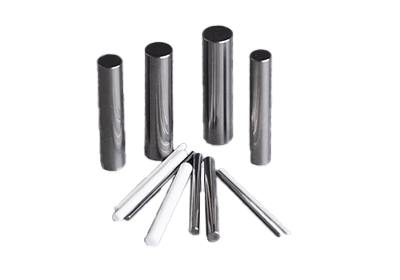What Are Pin Gauges?

Pin gauges are precision measurement tools primarily used to assess the inside diameter of holes in products and determine whether the hole size conforms to a specified standard.
Typically, sets of pin gauges with varying thicknesses are available. When measuring hole diameters using a length measuring machine like a 3-point micrometer, where results are obtained numerically, variations can occur based on the skill of the person performing the measurement.
However, pin gauges provide stable and consistent measurements, reducing variability regardless of the operator’s skill level.
Applications of Pin Gauges
Pin gauges find extensive use in the manufacturing and quality control processes of industrial products. They are especially valuable for measuring the inside diameter of small holes, which cannot be accurately measured with instruments like a 3-point micrometer. Pin gauges are employed to determine whether the hole diameter falls within the specified tolerances.
Furthermore, pin gauges can be utilized to measure the distance between two holes. By inserting pin gauges without play into each of the two holes, measuring the outer diameters of the pin gauges with a vernier caliper, and subtracting the radii of the pin gauges, the center-to-center distance between the two holes can be calculated.
Pin gauges also play a role in measuring gears. To evaluate the thickness of gear teeth, one parameter considered is the overpin dimension. This involves placing two Pin Gauges between gears, measuring the distance between the outer diameters of the pins, and using this measurement for assessing the thickness of gear teeth, both for external and internal gears.
Principles of Pin Gauges
Pin gauges belong to the category of measuring gauges.
These gauges are manufactured with strict control not only over their outside diameter but also regarding roundness and cylindricity. Due to their extremely high precision, pin gauges are inserted into the hole being evaluated. For instance, if a hole can admit a 3.05mm pin gauge but cannot accept a 3.10mm pin gauge, the bore diameter is determined to be within the range of 3.05mm to 3.10mm.
Additional Information on Pin Gauges
1. Handling of Pin Gauges
When handling pin gauges, temperature sensitivity should be taken into account. Most pin gauges have small diameters and low volume. Prolonged handling can lead to thermal expansion due to body heat.
Thermal expansion can cause the pin gauges to have a larger diameter than their indicated value. Despite their simple cylindrical design, pin gauges must be handled with care. Scratches on their surface can compromise their accuracy. Moreover, rust formation is a significant concern, especially for steel or superalloy pin gauges. Handling them with bare hands can introduce salt from sweat, leading to rust.
It is advisable to wear gloves when handling metal pin gauges. After handling them with bare hands, they should be wiped with a clean, soft cloth or leather and lightly coated with anti-corrosive oil.
2. Distinction from Plug Gauges
Plug gauges, like pin gauges, are inserted into the hole for evaluation. Plug gauges have two differently sized cylinders at each end, with one end serving as the “go” side and the other as the “no-go” side. This design allows for a quick determination of whether the inside diameter of the hole falls within the standard range.
Plug gauges are commonly used for holes with larger inside diameters compared to pin gauges since they facilitate relatively quick and straightforward inspections.
3. Materials Used in Pin Gauges
Pin gauges can be made from materials such as steel, cemented carbide, or ceramic.
Ceramic pin gauges are known for their ease of maintenance. They do not rust since they are not made of metal. However, they still require careful handling and should not be treated roughly simply because they do not corrode.